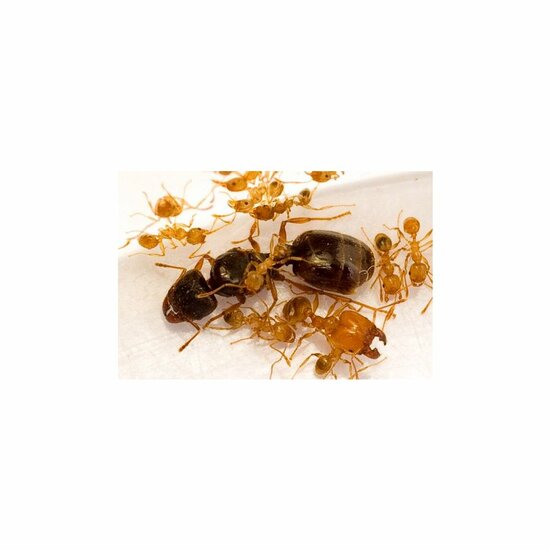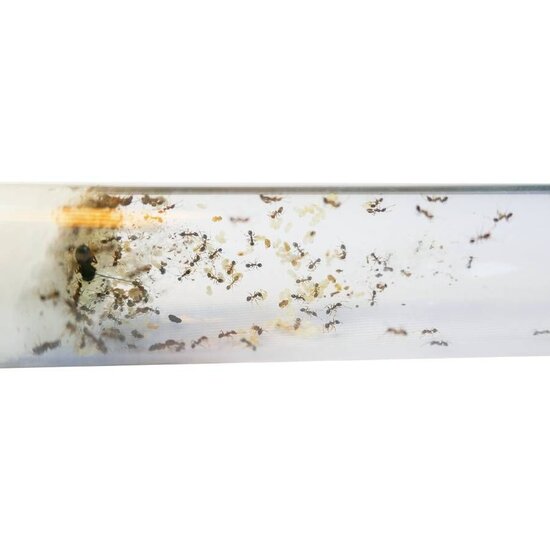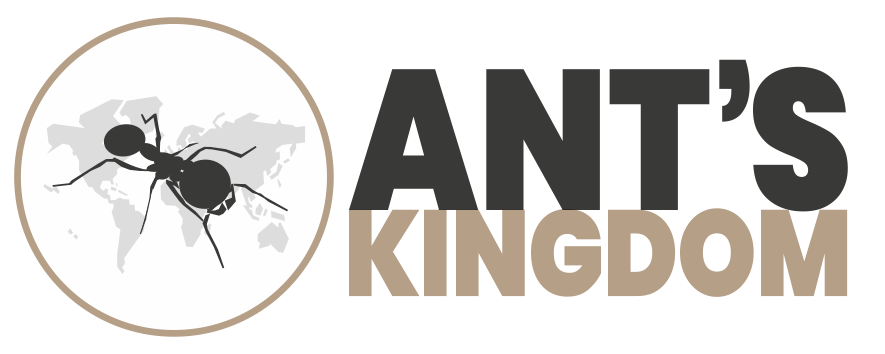



- Ants as pets since 2009 It starts here!
- We ship every working day until 4:30 PM
- Flat shipping costs from €6.99
- Specialists in ants, free advice
Do you have questions about this product?
Or do you need help? Please feel free to contact us, we are happy to help!
Product description
Pheidole pallidula 5-10 workers
Species
The ant pheidole pallidula, also called big-headed ant is a very small species found in South-Europe. They are aggressive against other ant species and leave the nest in relative big groups in search for food. They also have a lot more crave for nutrition than other ant species and are always looking after it.
An ant species that easily escapes, so make sure you are prepared and have a solid ant farm without gaps. Like the messor ants they also need a mixture of seeds. The colony can grow explosive, they are very active en there will be nice differences in size between the worker ants. (With bigger colonies there will be more and more bigger majors/soldiers).
Our ant colonies consist of a queen together with some breed and workers. The numbers depends on the number of eggs that developed themselves to ant (egg-larva-pupa-ant). This colony already consist of at least 5 workers which are raised by the queen ant herself. With this colony it is possible to see majors who are twice the size of the smaller workers.
Nutrition
the nutrition set above including seeds is a complete diet for this ant species. The set includes sugar water, honeydew, fruit flies and a starting kit with mixed seeds. The starting kit with seeds is enough for the first year.
Suitable for
The ant colony is intended for the ant farms of acrylic, gypsum and sand. We also recommend the use of an arena. Be sure that every part of your setup (also within ant farm nests) seals well, because these ants are well known for their escape abilities and urge.
The ants use the arena to get their nourishment and bring their garbage. Some of our products and offers have integrated an arena. For the first period of time the test tube has enough space for the colony. So they develop from the test tube.
If you are looking for ants to use in a gel ant farm, we recommend the ant family.
Packing and Shipping
In the image you see how we actually supply the ant colony. The colony is in a test tube with a water supply in order to keep the tube nest partially damp. After receipt the colony can be kept in the tube up to a few weeks without any care. We give a 2 weeks warranty for the life of the queen. Does the queen arrive dead or if she dies within a few weeks, we will provide a replacement colony for free.
Specification and information
Common use name
Big-headed ant
Scientific Name
Pheidole Pallidula
Difficulty
2. Experienced
Queen | Gyne:
7-8 mm
Workers:
2-5 mm
The bigger the colony, the bigger the ants can become.
Mediors en Majors (soldiers).
Kind of colony:
Monogyn and Polygyn
Colonies can exist out of more then one queen(gynes). But also with one queen the species will develop good.
Kind of nest:
Sandnests, relative shallow. Very wide, often under grass.
Temperature:
Roomtemperature, 20-30 degrees Celsius
Hibernation:
No, but a rest period. Our advice: slightly cooler with temperatures around 18 degrees during November-February. For example in the basement, a cooler attic or barn.
Our experience: even if you keep this species in winter on room temperature the ant colony will develop well.
Nutrition:
Sugar water, honeydew and small insects:
Our advice for smaller colonies: fruitflies.
Also a mixture of small seeds provides a continuum of fresh food.
Humidity:
Simple. Advice: Keep a part of the nest moist
This species prefers it's environment drier then for example Lasius Niger and Myrmica rubra
Natural habitat:
(South)Europe and (North)Africa
Advice Antfarm:
Acrylic, Gypsum or Sand including Arena area
Comments:
A very feisty, little ant. It's incredibly fascinating to watch how this species come out of the nest in huge numbers to gather food; especially when they haven't had some (fresh) food in some time. With good care the colony can expand with huge numbers. Pretty aggressive, so make sure your nest and arena are sealed correctly. The worker ants usually live shorter then other species (a few months), so the colony is constantly in development.
A start setup with test tube with the ant colony and a small arena is fine for these colonies, also a (smaller) acrylic or gypsum ant farm is fine to keep these ants.
Pheidole pallidula 5-10 workers
Species
The ant pheidole pallidula, also called big-headed ant is a very small species found in South-Europe. They are aggressive against other ant species and leave the nest in relative big groups in search for food. They also have a lot more crave for nutrition than other ant species and are always looking after it.
An ant species that easily escapes, so make sure you are prepared and have a solid ant farm without gaps. Like the messor ants they also need a mixture of seeds. The colony can grow explosive, they are very active en there will be nice differences in size between the worker ants. (With bigger colonies there will be more and more bigger majors/soldiers).
Our ant colonies consist of a queen together with some breed and workers. The numbers depends on the number of eggs that developed themselves to ant (egg-larva-pupa-ant). This colony already consist of at least 5 workers which are raised by the queen ant herself. With this colony it is possible to see majors who are twice the size of the smaller workers.
Nutrition
the nutrition set above including seeds is a complete diet for this ant species. The set includes sugar water, honeydew, fruit flies and a starting kit with mixed seeds. The starting kit with seeds is enough for the first year.
Suitable for
The ant colony is intended for the ant farms of acrylic, gypsum and sand. We also recommend the use of an arena. Be sure that every part of your setup (also within ant farm nests) seals well, because these ants are well known for their escape abilities and urge.
The ants use the arena to get their nourishment and bring their garbage. Some of our products and offers have integrated an arena. For the first period of time the test tube has enough space for the colony. So they develop from the test tube.
If you are looking for ants to use in a gel ant farm, we recommend the ant family.
Packing and Shipping
In the image you see how we actually supply the ant colony. The colony is in a test tube with a water supply in order to keep the tube nest partially damp. After receipt the colony can be kept in the tube up to a few weeks without any care. We give a 2 weeks warranty for the life of the queen. Does the queen arrive dead or if she dies within a few weeks, we will provide a replacement colony for free.
Specification and information
| Common use name | Big-headed ant |
| Scientific Name | Pheidole Pallidula |
| Difficulty | 2. Experienced |
| Queen | Gyne: | 7-8 mm |
| Workers: | 2-5 mm The bigger the colony, the bigger the ants can become. Mediors en Majors (soldiers). |
| Kind of colony: | Monogyn and Polygyn Colonies can exist out of more then one queen(gynes). But also with one queen the species will develop good. |
| Kind of nest: | Sandnests, relative shallow. Very wide, often under grass. |
| Temperature: | Roomtemperature, 20-30 degrees Celsius |
| Hibernation: | No, but a rest period. Our advice: slightly cooler with temperatures around 18 degrees during November-February. For example in the basement, a cooler attic or barn. Our experience: even if you keep this species in winter on room temperature the ant colony will develop well. |
| Nutrition: | Sugar water, honeydew and small insects: Our advice for smaller colonies: fruitflies. Also a mixture of small seeds provides a continuum of fresh food. |
| Humidity: | Simple. Advice: Keep a part of the nest moist This species prefers it's environment drier then for example Lasius Niger and Myrmica rubra |
| Natural habitat: |
(South)Europe and (North)Africa |
| Advice Antfarm: | Acrylic, Gypsum or Sand including Arena area |
| Comments: |
A very feisty, little ant. It's incredibly fascinating to watch how this species come out of the nest in huge numbers to gather food; especially when they haven't had some (fresh) food in some time. With good care the colony can expand with huge numbers. Pretty aggressive, so make sure your nest and arena are sealed correctly. The worker ants usually live shorter then other species (a few months), so the colony is constantly in development. |
Reviews
No reviews yet
More information...
If you have any questions, please don't hesitate to contact us, we like it! You can reach us via email and WhatsApp. You are welcome in the showroom by appointment for advice and purchase!
Customer service Make an appointment
